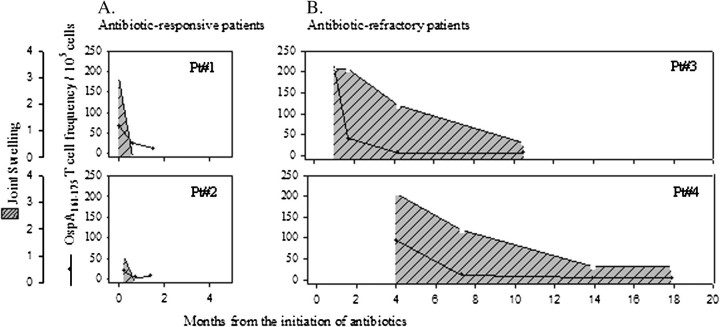Figure 2.
Correlation of the duration of joint inflammation and the frequency of Borrelia burgdorferi outer-surface protein A (OspA)161–175–specific T cells in peripheral blood in serial samples from 4 patients with antibiotic-responsive Lyme arthritis (antibiotic-responsive patients) or antibiotic-refractory Lyme arthritis (antibiotic-refractory patients). The 2 patients with antibiotic-responsive arthritis were first evaluated prior to antibiotic therapy, and both responded to a 1-month course of oral doxycycline. The 2 patients with antibiotic-refractory arthritis were first seen 1 and 4 months after the start of antibiotic therapy. Patient 3 (Pt#3) was treated with a 2-month course of oral doxycycline and a 1-month course of intravenous ceftriaxone. Patient 4 (Pt#4) received a 1-month course of doxycycline, followed 3 months later by a 1-month course of intravenous ceftriaxone. The cross-hatched areas show the amount of joint swelling, and the lines with closed circles show the frequency of OspA161–175-specific T cells. In both patients with antibiotic-responsive arthritis and those with antibiotic-refractory arthritis, the frequencies of OspA161–175-specific T cells decreased during the period of antibiotic therapy, whereas joint inflammation persisted for months longer in patients with antibiotic-refractory arthritis than in patients with antibiotic-responsive arthritis. Reproduced with permission from Kannian et al [20].

